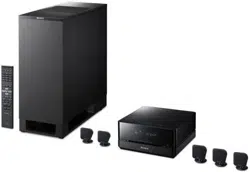Loading ...
Loading ...
Loading ...

masterpage:Left
specdef v20060111
filename[G:\F\FM\Sony\E\0628\DAVIS10_DMa\3276977111\3276977111DAVIS10\gb12adv.fm]
model name [DAV-IS10]
[3-276-977-11(1)]
90
US
x “INTERLACE” (NORMAL)
Select this setting when:
– your TV does not accept progressive signals,
or,
– the TV is connected to the VIDEO OUT
(VIDEO) jack.
x “PROGRE” (PROGRESSIVE)
Select this setting when:
– your TV accepts progressive signals, and,
– the TV is connected to the VIDEO OUT
(COMPONENT) jacks.
Normally select this if the above conditions are
met. This automatically detects the software
type, and selects the appropriate conversion
method. Note that the picture will not be clear or
no picture will appear if you select these settings
when either of the above conditions is not met.
Note
• When you connect the control unit and the TV with
the HDMI cable during the system is set to
“INTERLACE” (NORMAL), the system is set to
“PROGRE” (PROGRESSIVE) automatically.
Ti
p
• When you connect the control unit and the TV with
the HDMI cable, RESOLUTION is used for selecting
the type of video signals output from the HDMI OUT
jack. For details, see “To select the type of video
signal output from the HDMI OUT (high-definition
multimedia interface out) jack” (page 90).
About DVD software types and
the conversion method
DVD software can be divided into 2 types: film
based software and video based software.
Video based software is derived from TV, such
as dramas and sit-coms, and displays images at
30 frames/60 fields per second. Film based
software is derived from film and displays
images at 24 frames per second. Some DVD
software contains both video and film.
In order for these images to appear natural on
your screen when output in progressive format,
the progressive signals need to be converted to
match the type of DVD software that you are
watching.
Note
• When you play video based software in progressive
signal format, sections of some types of images may
appear unnatural due to the conversion process when
output through the VIDEO OUT (COMPONENT)
jacks. Even though you set to “PROGRE”
(PROGRESSIVE), images from the VIDEO OUT
(VIDEO) jack are unaffected as they are output in the
interlace format.
To select the type of video signal
output from the HDMI OUT (high-
definition multimedia interface
out) jack
When you connect the control unit and the TV
with the HDMI cable, select the type of video
signals output from the HDMI OUT (high-
definition multimedia interface out) jack.
For details, refer also to the operating
instructions supplied with the TV/projector, etc.
1 Press FUNCTION repeatedly to select
“DVD.”
2 Press RESOLUTION.
The current type of video signals appears in
the front panel display.
Each time you press RESOLUTION, the
display changes as follows:
• “480p*”: Sends [720 × 480p] video
signals.
• “720p*”: Sends [1280 × 720p] video
signals.
• “1080i*”: Sends [1920 × 1080i] video
signals.
* i: interlace, p: progressive
When connecting to a standard
4:3 screen TV
Depending on the disc, the image may not fit
your TV screen.
To change the aspect ratio, see page 88.
t “480p*”
r
“720p*”
r
“480p*”
r
“1080i*”
Loading ...
Loading ...
Loading ...
